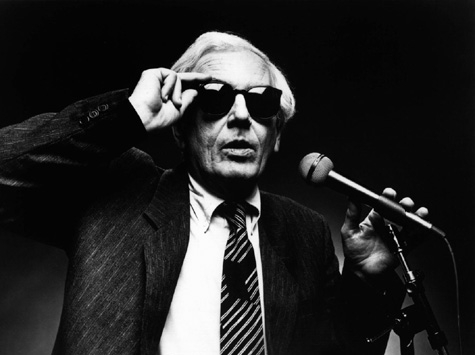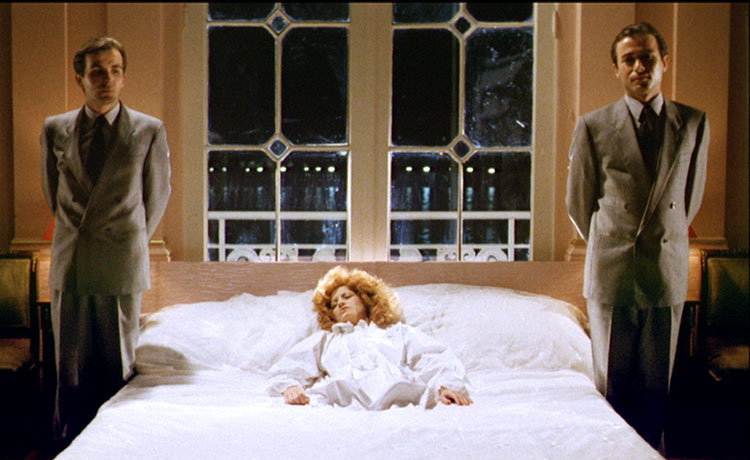In memory of Robert Ashley, 1930–2014

I first learned about Robert Ashley through Peter Greenaway, thanks to his Four American Composers series. I rented all four videos because I was interested in John Cage and Philip Glass. I didn’t know who Meredith Monk was, or Robert Ashley.
As it turns out, the episode on Ashley interested me the most. I didn’t understand the opera being discussed, Perfect Lives, but I knew I had to hear and watch the whole thing. I took to the internet and discovered that I could order it directly from Lovely Music, on VHS. I did so. It cost me $100—but I had to hear it.
Few people I knew at the time had ever heard of Robert Ashley. When I moved to Illinois and met Mark Tardi and Jeremy M. Davies, we bonded in part over our shared love for Perfect Lives, “an opera for television” made in the late 1970s and early 1980s. It’s still not widely known. It’s still never been broadcast in its entirety in the US. But I’m not alone alone in regarding it one of the greatest operas and long poems in the English language. (John Cage wrote of it: “What about the Bible? And the Koran? It doesn’t matter. We have Perfect Lives.”)
Some movie news plus videos to look at
1. Peter Greenaway and Jean-Luc Godard have made a 3D omnibus film (along with one Edgar Pêra). The 2D trailer is here, and you can find information online: CinemaScope / Fandor / The Hollywood Reporter / Mubi / Variety.
2. Guy Maddin is planning a moving-picture adaptation of Sparks’s radio drama / concept album / opera-thingy The Seduction of Ingmar Bergman.
3. A lot of people don’t know that David Lynch once made a video for Sparks, but you’re not one of them:
And this is also relevant.
4. While we’re all here, we might as well look at this.
5. As well as this. Pretty well-done, no?
Chasing the Red Herrings in Greenaway’s Z+OO: a symposium of myself
It starts with a crash. You do not see the crash. You hear it. You see the aftermath. Typical. A dead swan splayed over the hood of a white Ford Mercury. The first time I typed that, I typed Mercy. Different cars are very much different sorts of animals. Domesticated animals, of course. Crossbreeds. It is said that the different sorts of hominids did not, could not, cross. Put that in my zonkey’s ass. The woman driving the car, who will be accused of taking mercury to procure an abortion, is named Bewick. The Mercury is no longer produced. You could say it is extinct. It was Ford’s answer to the Buick, you could say it was a fake Buick, a car that would no longer be were it not for waning appeal among wealthy Chinese (the last Emperor drove one, so did my grandma). Rauschenberg was born in the same town as my mom. This scene, the first of A Zed & Two Noughts, looks like something he might have filmed in the sixties, if only he had combined his interests (visual & performance art) into film, the way he did with found objects, like his notorious American bald eagle (an animal that will be mentioned later in this film when a prostitute named Venus de Milo asks the zookeeper for the tail feathers of that bird in order to write a dirty story, the same zookeeper who will later threaten to tell the director of the zoo, who is in fact the director of the film, about the brothers bringing the dead dalmatian into the zoo because it is “an abomination”). But then Rauschenberg dealt with death in ways more conceptual, less actual. I remember riding in the back of my grandma’s Buick because it had a passenger-side airbag. I remember carefully visualizing my death. I remember oak trees. The accident happens on Swan’s Way. Way is one of the ten most common words in our language. Weeks ago, this surprised me. But it should not be surprising that the journey is more popular than the destination. We’re a restless race. We want tiggers in our tanks & Michael Nyman to speed up & O will he!
So Why Have You Not Seen “Hail the New Puritan”?
When I was a Master’s student at Illinois State University, I helped start and run a film club. We specialized in more obscure cinema. And one film I always wanted to show was Hail the New Puritan (1985–6), a fictionalized documentary by Charles Atlas about the British dancer and choreographer Michael Clark. It’s punk ballet!
The only problem was, I couldn’t find a copy of the film…
A Little Bit More on Cliché
Here’s the plot: a woman sees this guy and falls in love. The trouble is, her father is feuding with the fellow’s father.
Sound familiar?
This is a map made by an exiled pianist, as a directive to the members of his band. He could not foresee that his musical and topographical instruction should be used backwards. As a cartographer, he was not appreciated in his own country.
While trying and failing to embed Peter Greenaway’s hilarious film, A Walk Through H (1978), which is what I actually want you to watch here (so pardon this aside – it’s what I do), I found this 3D walk-through of the Beis Hamikdash in Jerusalem. This is the temple where, in the New Testament, Jesus is said to have prayed and chased merchants away, claiming they were desecrating the temple. The temple in this video. READ MORE >




